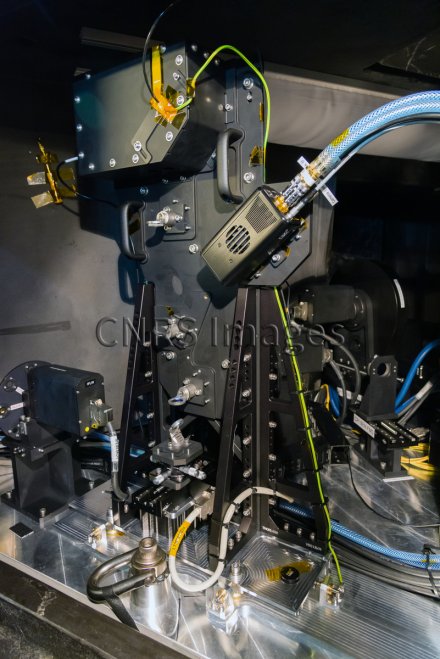Production year
2023

© Arthur VIGAN / LAM / CNRS Images
20230063_0001
Module d'injection de fibres du projet Hirise dans l’instrument Sphere, sur le Très Grand Télescope (VLT) de l'Observatoire européen austral (ESO), au Chili. Sphere permet d’observer en imagerie directe les exoplanètes autour d’étoiles proches de notre système solaire. Les imageurs à haut contraste comme celui-ci détectent les jeunes exoplanètes géantes dans le proche infrarouge, mais la faible résolution spectrale de leurs spectrographes à champ intégral limite leurs capacités à caractériser ces exoplanètes. Pour dépasser cette limitation, le projet Hirise (High-Resolution Imaging and Spectroscopy of Exoplanets) combine les capacités de Sphere avec celles d’un autre instrument du VLT, le spectrographe à très haute résolution Crires+. Le module d'injection de fibres prélève le signal de l'exoplanète connue par imagerie grâce à Sphere, et cette lumière est amenée par un toron de fibres jusqu'à un module d'extraction qui l'envoie dans Crires+. L’association de ces deux instruments permettra aux scientifiques de mieux comprendre la formation, l’évolution et la composition des exoplanètes observées en imagerie directe.
The use of media visible on the CNRS Images Platform can be granted on request. Any reproduction or representation is forbidden without prior authorization from CNRS Images (except for resources under Creative Commons license).
No modification of an image may be made without the prior consent of CNRS Images.
No use of an image for advertising purposes or distribution to a third party may be made without the prior agreement of CNRS Images.
For more information, please consult our general conditions
2023
Our work is guided by the way scientists question the world around them and we translate their research into images to help people to understand the world better and to awaken their curiosity and wonderment.